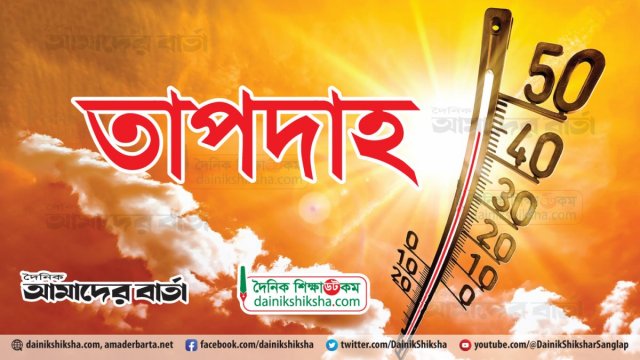Dainikshiksha Desk: The mild heatwave that started on Monday spread to most parts of Bangladesh by Tuesday afternoon, expanding to four entire divisions and a dozen districts elsewhere.
The divisions engulfed by the heatwave are Rajshahi, Rangpur, Sylhet, and Khulna, and the 12 districts being baked in the heatwave are from the rest of the four divisions of the country, including Dhaka.
Bangladesh’s highest maximum day temperature of 38.4C was recorded in Saidpur on Tuesday, while the day temperature in Dhaka rose to 35.2C.
‘Days will get even hotter over the next few days until the next wet spell sets in next week,’ meteorologist Tariful Newaz Kabir told New Age.
People have been advised to avoid going outside unless necessary, particularly between the hours of 12:00pm and 5:00pm, and stay hydrated by drinking a minimum of two litres of water every day.
Physicians have also advised people not to go under the sun without covering their heads, particularly children and elderly people.
A heatwave occurs when the day temperature reaches 36C.
The districts that are affected by the heatwave are Tangail, Faridpur, Madaripur, Kishoreganj, Netrakona, Rangamati, Cumilla, Noakhali, Feni, Cox’s Bazar, Bhola, and Patuakhali.
The rather comfortable weather condition of the past few days has been replaced by uncomfortable, hot weather in Dhaka, where individual environmental organisations often find day temperatures 5C hotter than what is officially reported.
The informal workers in Dhaka brace for another disruption in their income following the Met Office’s warning of day temperatures over the next two days increasing by up to 2C each.
May is the last month of the three-month-long pre-monsoon season, the hottest time of the year.
This pre-monsoon has been particularly warm, with a heatwave lasting for 37 days starting on the last day of March without a break. This was the longest heatwave ever recorded in Bangladesh.
During the last heatwave, the country’s highest day temperature of 43.8C was recorded in Jashore on April 30, the hottest day in over three decades.
Districts such as Chuadanga and Jashore saw day temperatures stay at 40C or above for almost three weeks between mid-April and early May.
Day temperatures frequently exceeded 40C in Dhaka, which saw its peak at 40.5C on April 30, the second hottest day in the capital in the past 64 years.
The last heatwave prompted the closure of educational institutions for over a week. At least 15 people died, according to the official account of the government.
Thousands of poultry birds died because of intense heat throughout April and early May, prompting the closure of many poultry farms.
Some schools in Dhaka have already advised their students to move to online classes if the new heatwave intensifies.
The new heatwave is set to decimate the production of fruits and fish.
Fish farmers remained on high alert as water levels were already depleted, particularly in northern Bangladesh, threatening to reduce dissolved oxygen and emit poisonous gases.
The Bangladesh Meteorological Department, in its weather bulletin issued on Tuesday afternoon, predicted rain at one or two places in Rajshahi, Rangpur, Khulna, Mymensingh, Sylhet, and Dhaka divisions.
The BMD revealed in its latest report titled ‘Changing Climate of Bangladesh’ that the maximum temperature in the pre-monsoon months rose between 1980 and 2020.
The report showed that parts of the northern, south-western, and south-eastern regions are especially prone to warmer days in the pre-monsoon season.
South-western and south-eastern regions became particularly hot in the pre-monsoon season between 1980 and 2020, according to the report.
The report showed that the pre-monsoon season grew rather drier with less rain between 1980 and 2020, with a decrease of 2.7 days in the number of rainy days every decade.
Power outages returned with the return of the heatwave as authorities reported 305MW of load-shedding at 1:00am on Tuesday with generation of 13,981MW.
Studies showed that heat stress can seriously affect productivity and that Bangladesh’s workforce and productivity can be seriously affected by extreme heat.
Adrienne Arsht-Rockefeller Foundation Resilience Center, a Washington-based non-government organisation, said in a recent report that Dhaka was losing $6 billion worth of labour productivity every year due to heat stress from extreme temperatures.
The loss of productivity, in other words, means heat waves are turning the poor even poorer, as millions of informal workers’ incomes depend on the work hours they put in.
The situation is particularly bad for women, who are paid less than men.
Another recent study by the Bangladesh Red Crescent Society revealed that hawkers surveyed lost up to 75 per cent of their earnings during heat waves.
A policy brief released last year by the University of Leeds and the London School of Economics and Political Science estimated that the workforce and productivity of Bangladesh could be decimated by up to 46 per cent over the next six decades because of heat stress caused by global warming. source: new age







